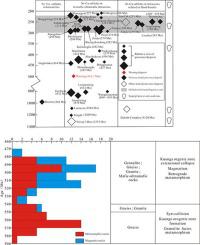Ore Geology Reviews ( IF 3.2 ) Pub Date : 2021-04-22 , DOI: 10.1016/j.oregeorev.2021.104189 Tao Zheng , Ye Qian , Yanjie Shen , Shengnan Tian , Changji Zhao , Yanming Xiu , Fengyue Sun

|
The Wuxing deposit in Northeast China, tectonically located in the Jiamusi–Khanka Block, is a Pt–Pd-rich Cu-Ni sulfide deposit related to mafic–ultramafic rocks. The zircon U–Pb ages of pyroxenites, gabbros, porphyritic granites, and leucogranits in the mining area are 516.7 ± 2.6, 513.8 ± 2.0, 505.4 ± 2.3 and 499.5 ± 2.9 Ma, respectively, indicating that the diagenesis and metallogenesis of the Wuxing deposit occurred during the Cambrian. The ore-forming complex is cut by quartz diorite porphyritic and plagiogranite porphyry dikes. Zircon U–Pb ages of the quartz diorite porphyrite and plagiogranite porphyry are 206.6 ± 2.1 and 201.6 ± 1.3 Ma, respectively. The U–Pb ages indicate the metallogenic age constraint of 516.7 ± 2.6 Ma for the Wuxing deposit, rather than Cambrian and Triassic magmatic activities. The Hf isotopic composition εHf(t) of zircons in the pyroxenites and gabbros are −11.5 to −7.7 and −5.8 to −2.5, with the two–stage model ages (tDM2) of 2198–1958 and 1841–1633 Ma, respectively. Geochemically, the mafic–ultramafic complexes are enriched in light rare earth elements (LREE) and large ion lithophile elements (LILE), and depleted in high-field strength elements (HFSE), indicating these rocks originated from the enriched mantle. The porphyritic granites are high-K calc-alkaline rocks (Rittman index δ = 1.92–2.00), and the leucogranites are low-K alkaline rocks (δ = 4.76–4.86) with εHf(t) and tDM2 of −9.2 to +0.8 and 2037–1411 Ma, respectively. The porphyritic granites and leucogranites are characterized by low A/CNK values (0.91–1.05), 10,000 Ga/Al values (1.76–2.36), and Zr saturation temperature (731–823 ℃) similar to those of I-type granites. Along with contemporaneous intrusions, the Wuxing deposit is inferred to have formed in a post-collisional extension environment. Consequently, the origin of the Wuxing deposit is likely related to the evolution of enriched mantle magma during the Cambrian post-collision extensional setting of the Jiamusi–Khanka Block.











































 京公网安备 11010802027423号
京公网安备 11010802027423号